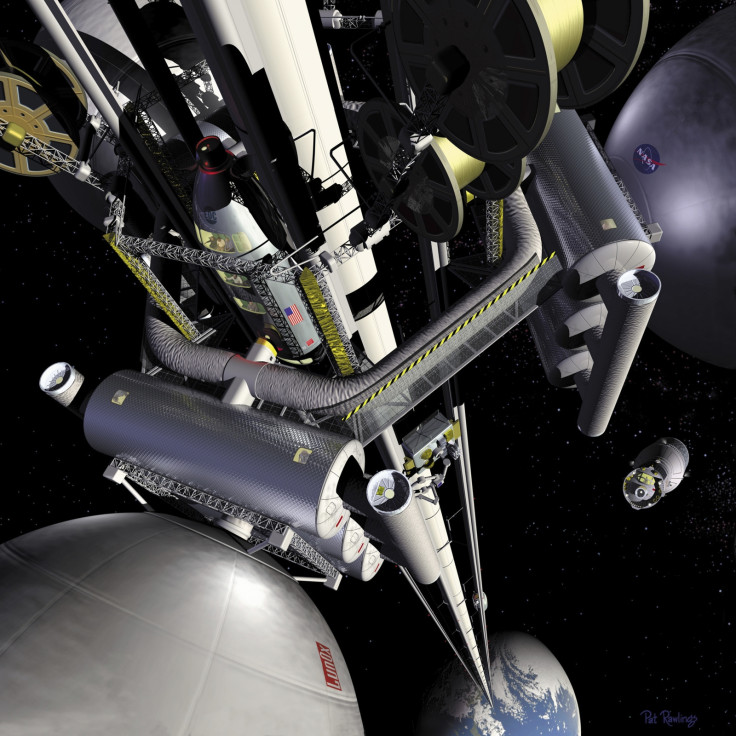A Space Elevator Could Now Be Possible With New Diamond Nanothread Invention

Scientists from Penn State University have discovered how to produce and string nanodiamonds together to form ultra-thin diamond nanothreads that could bring the long-held dream of space elevators to life, following almost a century of failed attempts by the international scientific community.
The researchers have succeeded in creating diamond nanothreads with extraordinary properties of strength and stiffness that are far stronger than today's nanotubes and polymers, using a specialised, large-volume, high-pressure device to compress benzene up to 200,000 atmospheres.

The high pressures caused the benzene to spontaneously polymerise into long, thin strands made up of hexagonal rings of carbon atoms in chains, rather than the usual three-dimensional lattice structure of a diamond.
Their research, entitled "Benzene-derived carbon nanothreads", has been published in the latest issue of the journal Nature Materials.
"Because this thread is a diamond at heart, we expect that it will prove to be extraordinarily stiff, extraordinarily strong, and extraordinarily useful," said John Badding, a chemistry professor at Penn State University who led the research.
"One of our wildest dreams for the nanomaterials we are developing is that they could be used to make the super-strong, lightweight cables that would make possible the construction of a 'space elevator' which has so far only existed as a science-fiction idea."
The great glass elevator
The idea for a space elevator stretches all the way back to 1895, when the concept was first published by Soviet rocket scientist Konstantin Tsiolkovsky.

Although Tsiolkovsky envisioned a free-standing tower stretching from the Earth's surface to a high-enough altitude beyond geostationary orbit of at least 35,800km, the modern concept for a space elevator is a transportation system where a vehicle can be transported along a cable anchored at the equator.
The other end of the cable is anchored with a counterweight, and due to the competing forces of gravity (outward/upward centrifugal force), the cable holds up by itself in a stationary position.
One of many ideas for the space elevator is author Roald Dahl's Charlie and the Great Glass Elevator, published in 1972, which tells the tale of Charlie and Mr Willy Wonka going to space in a literal glass elevator (after Charlie takes ownership of the chocolate factory) and docking on a Space Hotel owned by the US government.
In the last 14 years, a predominant concept from scientists has been to create a space elevator made from carbon nanotube technology, and Japan is keen to be the first country to bring this invention to life by 2050.
How the nanothreads are built
The nanothreads are essentially invisible to the human eye as each thread is less than a nanometre in diameter, which is not surprising given that nanodiamonds, before being compressed, are already 100,000 times narrower than a strand of hair.
Numerous other laboratories in the world and many scientists have failed to compress separate carbon-containing molecules into a nanomaterial for almost a century, which is what makes this invention so exciting for the future of astronautics.
"It is as if an incredible jeweller has strung together the smallest possible diamonds into a long miniature necklace. That the atoms of the benzene molecules link themselves together at room temperature to make a thread is shocking to chemists and physicists," said Badding.
"Considering earlier experiments, we think that, when the benzene molecule breaks under very high pressure, its atoms want to grab onto something else but they can't move around because the pressure removes all the space between them.
"This benzene then becomes highly reactive so that, when we release the pressure very slowly, an orderly polymerisation reaction happens that forms the diamond-core nanothread."
At the moment, the high pressures that the scientists are using can only make a couple of cubic millimetres at a time, so their next step would be to figure out how to make enough so that the material can be used at an industrial scale.
The team's research also opens up the possibility to add other types of atoms to cores of carbon and hydrogen, in order to create other new, potentially strong and light materials.
© Copyright IBTimes 2024. All rights reserved.







